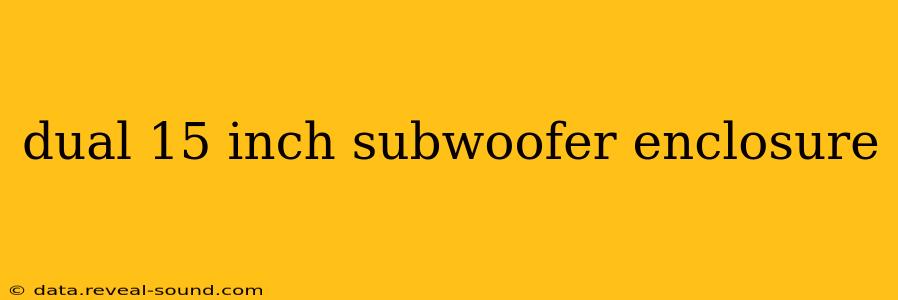Building a dual 15-inch subwoofer enclosure is a significant undertaking for any audio enthusiast. It requires careful planning, precise construction, and a deep understanding of acoustic principles to achieve optimal performance. This guide delves into the key considerations, from design choices to construction techniques, ensuring you build a system that delivers earth-shattering bass with clarity and accuracy.
What are the Benefits of a Dual 15-Inch Subwoofer Enclosure?
The primary advantage of a dual 15-inch setup lies in its increased output capacity compared to a single 15-inch subwoofer. Two drivers working in unison deliver significantly more power and can produce much lower frequencies with greater efficiency. This translates to louder, deeper, and more impactful bass in your listening environment. However, the increased power also demands a larger and more robust enclosure.
What Type of Enclosure is Best for Dual 15-Inch Subwoofers?
Several enclosure types are suitable for dual 15-inch subwoofers, each with its own sonic characteristics:
-
Sealed: Sealed enclosures are simple to build, requiring less expertise and materials. They offer tight, controlled bass with good transient response, ideal for music with precise bass lines. However, they generally produce less overall output than ported enclosures.
-
Ported (Bass Reflex): Ported enclosures utilize a port (tube) to reinforce specific bass frequencies, resulting in significantly higher output. They are excellent for home theater applications where overwhelming low-end power is desired. However, they require more precise design calculations and can be more challenging to build.
-
Bandpass: Bandpass enclosures are more complex, utilizing multiple chambers to isolate specific frequency ranges. They offer extremely high output within a narrow frequency range, but can be challenging to design and tune correctly. These are often used in specialized applications.
Choosing the right enclosure type depends on your listening preferences and the intended use of the subwoofer system.
What are the Dimensions of a Typical Dual 15-Inch Subwoofer Enclosure?
There's no single "typical" dimension. The ideal dimensions depend heavily on the chosen enclosure type (sealed, ported, bandpass), the specific subwoofer drivers used, and the desired tuning frequency (for ported and bandpass enclosures). Using subwoofer design software is crucial to calculate precise internal volume and port dimensions. Many free and commercial programs are available online that can assist with this process. Improper dimensions can lead to significantly reduced performance or even damage to the drivers.
How Much Power Do I Need for a Dual 15-Inch Subwoofer Enclosure?
The power requirements depend on the sensitivity and power handling capabilities of the chosen subwoofers. Generally, dual 15-inch subwoofers benefit from substantial amplification—think in the range of 1000 watts or more, depending on the specific drivers. Always check the manufacturer's specifications to ensure you don't overpower or underpower your subwoofers.
What Materials Are Best for Building a Dual 15-Inch Subwoofer Enclosure?
Durability and stiffness are key. MDF (Medium-Density Fiberboard) is a popular choice due to its excellent damping properties and ability to resist vibrations. Plywood is another option, but requires more careful sealing to prevent sound leakage. Avoid using materials that are too flexible, as they can negatively impact the enclosure's performance.
How to Design a Dual 15-Inch Subwoofer Enclosure?
Designing an enclosure demands precise calculations to optimize performance. This typically involves using subwoofer design software, inputting the subwoofer's Thiele-Small parameters (provided by the manufacturer), and specifying your desired enclosure type and tuning frequency (if applicable). The software will then generate the optimal internal volume, port dimensions (if ported), and bracing requirements.
This detailed guide provides a foundation for building a powerful and accurate dual 15-inch subwoofer enclosure. Remember to prioritize careful planning, accurate measurements, and high-quality materials for optimal results. The journey of building such a system can be rewarding, culminating in a truly immersive listening experience.
